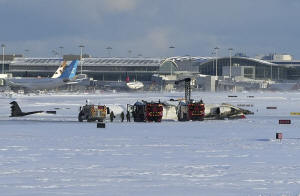Delta jet flips upside down on a snowy Toronto runway and all 80 aboard
survive
 Send a link to a friend
Send a link to a friend
 [February 18, 2025]
By JOHN WAWROW and MICHAEL CASEY [February 18, 2025]
By JOHN WAWROW and MICHAEL CASEY
TORONTO (AP) — A Delta Air Lines jet flipped on its roof while landing
Monday at Toronto’s Pearson Airport, but all 80 people on board survived
and those hurt had relatively minor injuries, the airport’s chief
executive said.
Snow blown by winds gusting to 40 mph (65 kph) swirled when the flight
from Minneapolis carrying 76 passengers and four crew attempted to land
at around 2:15 p.m. Communications between the tower and pilot were
normal on approach and it's not clear what went so drastically wrong
when the plane touched down.
Peter Carlson, a passenger traveling to Toronto for a paramedics
conference, said the landing was “very forceful.”
“All the sudden everything just kind of went sideways and then next
thing I know it’s kind of a blink and I’m upside down still strapped
in,” he told CBC News.
Canadian authorities held two brief news conferences but provided no
details on the crash. Video posted to social media showed the aftermath
with the Mitsubishi CRJ-900LR overturned, the fuselage seemingly intact
and firefighters dousing what was left of the fire as passengers climbed
out and walked across the tarmac.
“We are very grateful there was no loss of life and relatively minor
injuries,” Deborah Flint, CEO of Greater Toronto Airports Authority,
told reporters.
Delta CEO Ed Bastian said in a statement that “the hearts of the entire
global Delta family are with those affected."

Toronto Pearson Fire Chief Todd Aitken said 18 passengers were taken to
the hospital. Earlier in the day, Ornge air ambulance said it was
transporting one pediatric patient to Toronto’s SickKids hospital and
two injured adults to other hospitals in the city.
Emergency personnel reached the plane within a few minutes and Aitken
said the response “went as planned.” He said "the runway was dry and
there was no cross-wind conditions.”
The crash was the fourth major aviation accident in North America in the
past three weeks. A commercial jetliner and an Army helicopter collided
near Reagan National Airport in Washington, D.C., on Jan. 29, killing 67
people. A medical transportation plane crashed in Philadelphia on Jan.
31, killing the six people on board and another person on the ground.
And on Feb. 6, 10 people were killed in a plane crash in Alaska.
The last major crash at Pearson was on Aug. 2, 2005, when an Airbus A340
landing from Paris skidded off the runway and burst into flames amid
stormy weather. All 309 passengers and crew aboard Air France Flight 358
survived the crash.
On Monday, Pearson was experiencing blowing snow and winds of 32 mph (51
kph) gusting to 40 mph (65 kph), according to the Meteorological Service
of Canada. The temperature was about 16.5 degrees Fahrenheit (minus 8.6
degrees Celsius).
The Delta flight was cleared to land at about 2:10 p.m. Audio recordings
show the control tower warned the pilots of a possible air flow “bump”
on the approach.
“It sounds to me like a controller trying to be helpful, meaning the
wind is going to give you a bumpy ride coming down, that you’re going to
be up and down through the glide path,” said John Cox, CEO of aviation
safety consulting firm Safety Operating Systems in St. Petersburg,
Florida.
“So it was windy. But the airplanes are designed and certified to handle
that,” Cox said. “The pilots are trained and experienced to handle
that.”

[to top of second column]
|

Pearson International Airport firefighters work on an upside down
Delta Air Lines plane, which was heading from Minneapolis to Toronto
when it crashed on the runway, in Toronto, Monday, Feb. 17, 2025.
(Teresa Barbieri/The Canadian Press via AP)

The plane came to a rest at the intersection of Runways 23 and 15L,
not far from the start of the runway. Just after the crash, tower
controllers spoke with the crew of a medical helicopter that had
just left Pearson and was returning to help.
“Just so you’re aware, there’s people outside walking around the
aircraft there,” a controller said.
“Yeah, we’ve got it. The aircraft is upside down and burning,” the
medical helicopter pilot responded.
Carlson was among those outside the aircraft. He said when he took
off his seat belt he crashed onto the ceiling, which had become the
floor. He smelled gas, saw aviation fuel cascading down the cabin
windows and knew he needed to get out but said his fatherly
intuition and paramedic skills kicked in. He looked for those he
could help.
Carlson and another man assisted a mother and her young son out of
the plane and then Carlson dropped onto the tarmac. Snow was blowing
and it “felt like I was stepping onto tundra.”
“I didn’t care how cold it was, didn’t care how far I had to walk,
how long I had to stand — all of us just wanted to be out of the
aircraft,” he said.
Cox, who flew for U.S. Air for 25 years and has worked on U.S.
National Transportation Safety Board investigations, said the
CRJ-900 aircraft is a proven aircraft that’s been in service for
decades and does a good job of handling inclement weather.
He said it's unusual for a plane to end up on its roof.
“We’ve seen a couple of cases of takeoffs where airplanes have ended
up inverted, but it’s pretty rare,” Cox said.
Among the questions that need to be answered, Cox said, is why the
crashed plane was missing its right wing.
“If one wing is missing, it’s going to have a tendency to roll
over,” he said. “Those are going to be central questions as to what
happened to the wing and the flight data recorder and cockpit voice
recorder. They will be found, if not today, tomorrow, and the
Transportation Safety Board of Canada will read them out and they
will have a very good understanding of what actually occurred here.”

The U.S. Federal Aviation Administration said in a statement that
the Transportation Safety Board of Canada would head up the
investigation and provide any updates. The NTSB in the U.S. said it
was sending a team to assist in the Canadian investigation.
Endeavor Air, based in Minneapolis, is a subsidiary of Delta Air
Lines and the world’s largest operator of CRJ-900 aircraft. The
airline operates 130 regional jets on 700 daily flights to over 126
cities in the U.S., Canada and the Caribbean, according to the
company’s website.
The CRJ-900, a popular regional jet, was developed by Canadian
aerospace company Bombardier. It’s in the same family of aircraft as
the CRJ-700, the type of plane involved in the midair collision near
Reagan National Airport on Jan. 29.
___
Casey reported from Concord, New Hampshire. Associated Press
journalists Michael Sisak in New York, Jack Dura in Bismarck, North
Dakota, Alex Veiga in Los Angeles, and Jim Morris in Vancouver,
British Columbia, contributed reporting.
All contents © copyright 2025 Associated Press. All rights reserved |